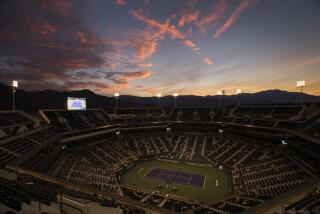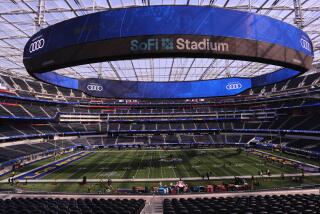Ashe Stadium Doesn’t Serve the Sport’s True Needs
- Share via
NEW YORK — A stadium for which there is a questionable need opens this week bearing the name of a man with unquestionable credentials.
The Arthur Ashe Stadium--the largest tennis arena in the world--will make its debut Monday as the U.S. Open begins at the U.S. Tennis Center in Flushing Meadows.
The huge, bowl-like stadium has been six years in the planning and 2 1/2 years in construction. So, after years of enduring the status of least-liked Grand Slam tournament, the U.S. Open will present its new face this week.
The 20,000-seat Louis Armstrong Stadium has been refitted to seat 10,000 and will serve as the backup to the larger Arthur Ashe Stadium, which, inevitably, has been described as state of the art.
“It’s a great impression, just walking in there and seeing the new seats,” Pete Sampras said last week. “It’s really a nice, beautiful stadium to play in. It’s totally different. I mean, the locker room facilities are much nicer. It just has a whole new feel to the U.S. Open. I think the players are looking forward to having the new stadium.”
The new stadium is part of a two-phase project, to be completed in 1998. And it’s not only a new stadium. The cramped and clogged grounds have been greatly expanded and now cover 48 acres. Anyone who has tried to shoulder through the teeming crowds here knows what a luxury personal space can be.
Seating has been improved at the outer courts, where each court now has its own seating area and views from all sides. More courts have been added, as well, bringing the number of outdoor courts to 33 and indoor practice courts to nine.
The new Ashe court is a four-story structure seating 22,547, a Goliath by tennis’ intimate standards. Also unique in tennis are the 90 luxury suites. Each box reportedly goes for $85,000 for the duration of the tournament.
Speaking of money, building costs were estimated at $245 million, although last winter’s difficult conditions are expected to push that figure higher. Of that, $150 million was financed by the sale of tax-exempt bonds. The rest was funded by the U.S. Tennis Assn.
Question is, is such a luxurious building needed? How does the USTA justify erecting a $245-million structure that will be used for two weeks a year when the sport is struggling in this country and the hottest issue is who will create and nurture the next generation of professional players?
There’s no argument that the old facilities were inadequate, for fans, players and others. But to solve that with the side-by-side huge arenas seems overkill. No new construction can change the immutable fixtures of the U.S Open--the heat and humidity of a stubborn summer, thunderstorms that stop play, the loud and inattentive crowds, the traffic, the noise, the smell of fried meat wafting over the court, La Guardia airport . . .
The construction was driven by another need, the need for more money. The new concessions, greatly increased seating and the luxury boxes will generate millions in income. The question becomes, where will the money go?
It is fitting that the first official activity on the court will include children. Saturday was Arthur Ashe Kids’ Day, a fund-raising event to benefit the Arthur Ashe Endowment for the Defeat of AIDS. The formal opening of the court will be held before Monday night’s matches.
This, no doubt, would please the late Arthur Ashe, who was dedicated to developing young players and bringing tennis to minority communities.
Ashe won the U.S. Open singles title in 1968, becoming the first African American man to win a Grand Slam tournament title. Twenty-nine years later the unfinished aspect of his legacy is that he is the last African-American player to have won a Grand Slam event. He died in 1993.
“Arthur Ashe was an outstanding tennis player,” USTA President Harry Marmion said. “But we are naming our new stadium in his honor because Arthur Ashe was the finest human being the sport of tennis has ever known. Arthur was--and through the example he set, still is--a role model to people throughout the world. It is only fitting that we recognize one of the brightest stars of tennis’ past through the facility that will be the focus of tennis’ future.”
So the USTA chooses to piggyback on Ashe’s good name, yet has done little to further the projects so dear to his heart. With an annual budget of $135 million, the USTA is in financial position to “grow the game,” as its officials like to say. With the unimaginable new income generated from a 20,000-seat stadium, what does the USTA plan to do with that money? What debt to Ashe does the USTA feel obligated to pay?
Would Ashe have approved building a new stadium with money that might have gone to develop the sport? Or would he have argued that a quarter of a billion dollars might have been better spent?
Sampras guesses Ashe would have disapproved of the expenditure, preferring money spent for player development.
“I didn’t know Arthur well, but that was something he was much interested in,” Sampras said.
Marmion says the stadium will generate a debt burden of $1.2 million a month.
“We cannot afford to fail,” he said.
Correct, but if the USTA truly wants to honor Ashe, it should dedicate itself to using the profit from the Ashe stadium to develop a generation of tennis players in his mold.
(BEGIN TEXT OF INFOBOX / INFOGRAPHIC)
U.S. OPEN ’97
Monday-September 7
* NO. 1-SEEDED PLAYERS FOR THE U.S.OPEN
Pete Sampras, Tampa, Fla.
Martina Hingis, Switzerland
* 1997 PRIZE MONEY
(Men’s & Women’s Singles)
Winners: $650,000
Runners-up: $350,000
TOTAL: $11,821,89
1996 CHAMPIONS
Pete Sampras--men’s singles
Steffi Graf--women’s singles
U.S. OPEN HISTORY
The first U.S. Open (open to professionals and amateurs) was held in 1968 at West Side Tennis Club in Forest Hills, N.Y., and was won by Arthur Ashe, who was playing as an amateur. The U.S. Open moved to its present home in Flushing in 1978. Before 1968, the event was called the U.S. Nationals, dating to 1881 when the first men’s singles championship was held. The first women’s singles championship dates to 1887.
Source: United States Tennis Assn.
(BEGIN TEXT OF INFOBOX / INFOGRAPHIC)
U.S. Open Television Schedule
* MONDAY: 8 a.m.-1 p.m., 4:30-8 p.m., USA; 12:30-1 a.m., highlights, Channel 2
* TUESDAY: 8 a.m.-1 p.m., 4:30-8 p.m., USA; 12:30-1 a.m., highlights, Channel 2
* WEDNESDAY: 8 a.m.-1 p.m., 4:30-8 p.m., USA; 12:30-1 a.m., highlights, Channel 2
* THURSDAY: 8 a.m.-1 p.m., 4:30-8 p.m., USA; 12:30-1 a.m., highlights, Channel 2
* FRIDAY: 8 a.m.-1 p.m., 4:30-8 p.m., USA; 12:30-1 a.m., highlights, Channel 2
* SATURDAY: 8 a.m.-3 p.m., Channel 2; 4:30-8 p.m., USA; 12:30-1 a.m., highlights, Channel 2
* AUG. 31: 8 a.m.-3 p.m., Channel 2; 4:30-8 p.m., USA; 12:30-1 a.m., highlights, Channel 2
* SEPT. 1: 8 a.m.-3 p.m., Channel 2; 4:30-8 p.m., USA; 12:30-1 a.m., highlights, Channel 2
* SEPT. 2: 8 a.m.-3 p.m., 4:30-8 p.m., USA; 12:30-1 a.m., highlights, Channel 2
* SEPT. 3: 8 a.m.-3 p.m., 4:30-8 p.m., quarterfinals, USA; 12:30-1 a.m., highlights, Channel 2
* SEPT. 4: 8 a.m.-3 p.m., 4:30-8 p.m., quarterfinals, USA; 12:30-1 a.m., highlights, Channel 2
* SEPT. 5: 8 a.m.-3 p.m., women’s semifinals, Channel 2; 12:30-1 a.m., highlights, Channel 2
* SEPT. 6: 8 a.m.-4 p.m., men’s semifinals, Channel 2
* SEPT. 7: 11 a.m.-4 p.m., men’s and women’s finals, Channel 2
More to Read
Go beyond the scoreboard
Get the latest on L.A.'s teams in the daily Sports Report newsletter.
You may occasionally receive promotional content from the Los Angeles Times.











